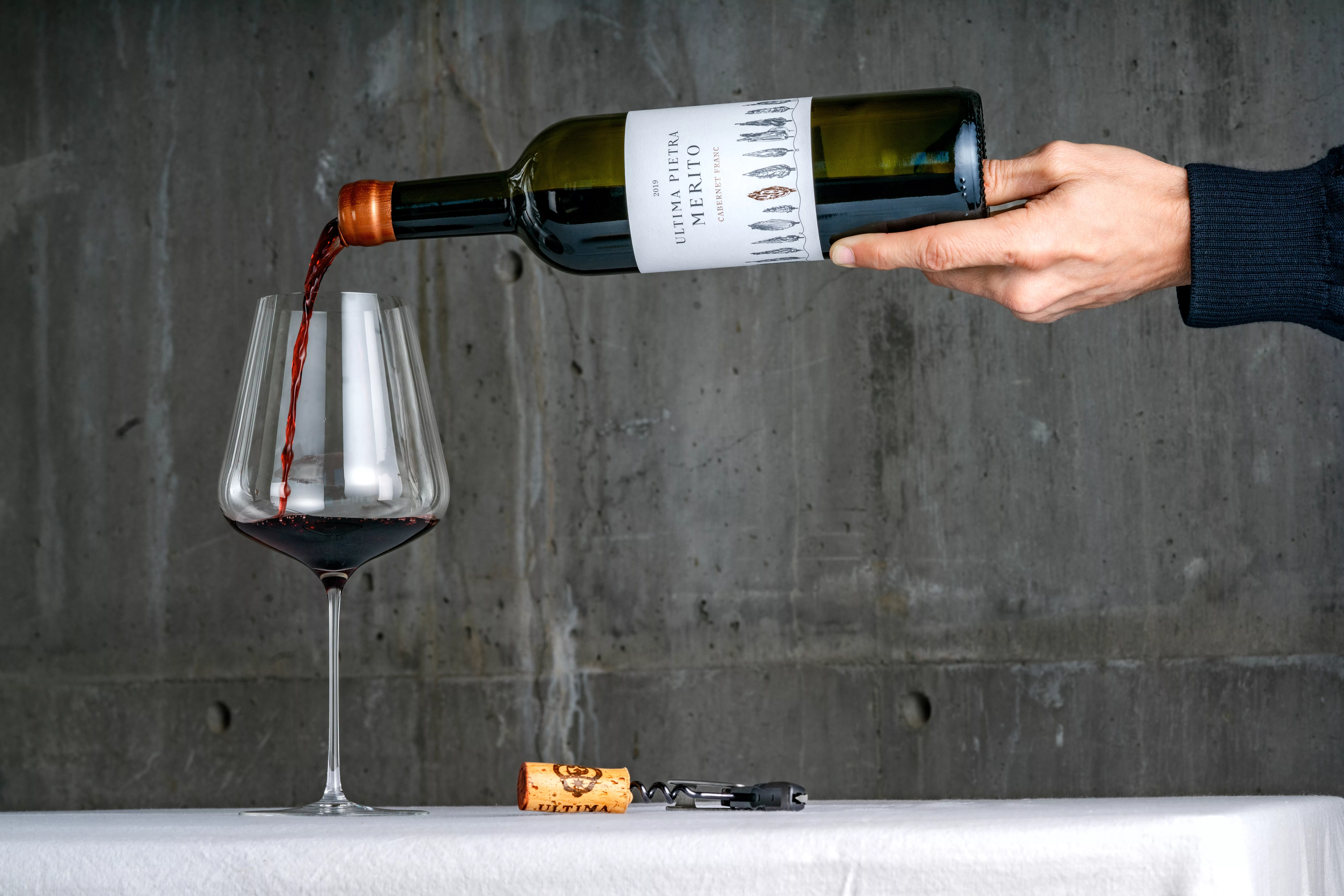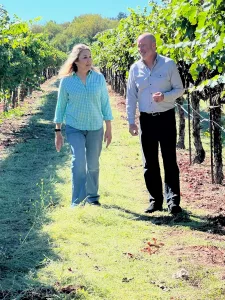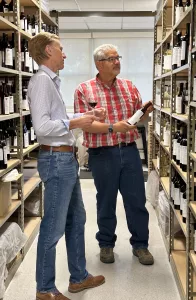
Investing in the North Bay’s wine industry is usually a multi-year commitment, one in which investment (ROIs) are rare and backers require luck and patience. Investors should look for a winemaker, winery or wine grape grower who demonstrates passion and works well with former colleagues and family members.
Many North Bay wineries are family-owned or have already bought out early investors. This means today’s investment opportunities often involve alternative ventures, like the development of new brands and the creation of blends. A number of these efforts utilize grapes or wine from regions beyond the North Bay. Some even involve partnerships with and acquisitions of wineries outside California. Still, investors can find the winemakers, wineries and vineyards to connect them to these openings in Marin, Napa and Sonoma counties.

One of the most helpful tips for potential investors is to use the lived experience of residing in the North Bay to deepen an understanding of the wine industry. It is also helpful to have connections to local wineries—even if it’s from having been a wine club member or had a winery or winemaker as a former client.
Wine industry experts advise that investors should become familiar with changes that are currently affecting businesses in the North Bay and beyond. These include global warming due to climate change, growing wildfire risk, rising insurance and land costs, and higher interest rates. Investors should also educate themselves on data relating to consumption and value. For example, they should be aware that wine consumption rose during the first two years of the COVID-19 pandemic but dropped to normal levels this year. In addition, investors should be aware of which areas beyond the North Bay, from Lodi to Paso Robles, are gaining prestige as wine-growing regions.
Before committing funds, investors should talk to a consultant, certified public accountant (CPA) or lawyer experienced with wine-related contracts. This will help them gain an understanding of financial records to review prior to signing paperwork and what Non-Disclosure Agreements (NDAs) are likely to contain.
“The most important piece of advice I give potential investors is that it takes a long time to see a financial return. The business may have to build the winery, plant vines, wait for them to bear fruit, age the wine and offer it for sale. The average winery takes 10 years to break even,” says Tim Allen, CPA and managing partner of Allen Wine Group in Santa Rosa.
Allen says many investors and wineries view acquiring a stake in a wine-related venture as a lifestyle.
“Once you’re in it, you’re usually in it for the very long-term. There’s often no resale market,” says Allen.
Getting in on the ground floor
Andy Steinman, partner in Global Wine Partners in St. Helena, is also partner and the chief financial officer of Walter Scott Wines in Salem, Oregon.
Walter Scott Wines was founded by Erica Landon and Ken Pahlow in 2008 as a side project while the owners were working for other parties. The Steinmans invested in the project in 2012 when Landon and Pahlow sought to fulfill their dream and make Walter Scott a full-time endeavor.
Fifteen years later, the 6,500-case winery has garnered notable attention for its chardonnay and pinot noir. The wine grapes are grown in the Willamette Valley’s Eola-Amity Hills.
“We got very lucky. But part of the reason that the relationship between us and Ken and Erica is solid is because we knew one another years before they started Walter Scott. In addition, we all agreed on our expectations at the start,” says Steinman.
The Steinmans made an “arm’s length” financial investment, meaning that they would leave the winemaking and marketing to Erica and Ken. The two winery owners strengthened their relationship with the Steinmans by regularly disclosing their plans for growth. Andy Steinman did the financial planning to support those plans.
“My background in winery investment helps me ensure they are making good choices. I’m aware that if we got involved in a Napa Valley winery, the costs would be seven to 10 times the amount they are in Oregon,” says Steinman.
Newcomers to the wine industry often believe it is easier to make a profit in a “leisure” industry like wine than in a more corporate-minded industry such as biotech. Steinman says this is not accurate. He encourages investors to see wine as a specialized sector of agribusiness.
“An investor could also find an opportunity in backing a new vineyard management company or other product or service supporting the industry. These can do well and do not have the financial complexity of a winery,” says Steinman.
How credit unions and grape brokers see wineries
North Bay Credit Union in Santa Rosa has offered financing options to North Bay wineries for 78 years.
“We provide loans to wineries for everything from acquiring new vineyards and equipment to purchasing irrigation systems and dealing with operating costs. We don’t take an equity position in wineries or vineyards,” says Chris Call, CEO of North Bay Credit Union.

Call’s advice for new investors is to look for individuals with experience.
“Especially if you’re brand new to the wine industry, you want to invest in businesses that are familiar with the challenges they will face. We do a stringent review to make sure a winery is a safe bet for lending,” says Call.
This includes reviewing the information on the land, which should be in good condition, and ensuring the property has a history of producing viable crops. The business should have mature vines, if possible, or a plan to cover costs until three years after planting. The people involved should have a good credit history, a low amount of debt, enough cash flow to hold the business until the first year of sales, and familiarity with wine and grape contracts.
“We look for individuals who monitor grape trends and understand which varietals are selling,” says Call.
Glenn Proctor, partner and broker for The Ciatti Company in Novato, agrees that new owners should have an understanding of the current market. Ciatti brokers deals between buyers and sellers for bulk wine, grapes, juice concentrate and spirits on a global scale.

“There have been opportunities to make money in the past because the wine industry has seen 2-to-3% growth every year since the early 1990s. But recently we have seen flat wine sales, and with limited growth. Also inflation has caused costs for equipment and production to rise. A lot of wineries, especially in Napa and Sonoma counties, are figuring out what’s an acceptable margin,” says Proctor.
The adage is typically that the easy part of the process is making wine and the hard part is selling it.
“That’s why you look for an individual or team who shows you they are aware of brand strength, margin return and cost structure. The person asking for an investment should understand the consumer proposition, [meaning the] consumer attraction and route to market on their wine product. [They should] make sure it is grounded in the current business realities,” says Proctor.
Avoid litigation, learn what labels sell
James “Jim” Rose, lawyer and shareholder in Buchalter Law Group, is based in St. Helena. Rose currently advises between 50 and 60 wineries in matters such as vineyard leases, grape purchasing agreements and custom crush arrangements.
Rose says investors should be careful of getting involved with businesses engaged in land disputes.
“Many parcels were created shortly after the Civil War. So they’re not exactly accurate. Now there are better ways to survey land. But it takes time and money for a winery or vineyard to win a legal battle,” says Rose.
Rose says one of the best reasons to become an investor in a North Bay wine venture is prices for Napa and Sonoma wines are substantially higher than wines from California’s Central Valley.
“The demand, the climate, the quality and the talent are all here. There’s a synergy of extremely talented people in the North Bay. Some of them are investors themselves,” says Rose.
He adds that many of the people in the local wine industry are sophisticated in terms of new ventures.
“You have to make good wine and be a master promoter to sell wine and bring in visitors here. I encourage investors to look for winemakers who have a unique personality and back it up with a quality product,” says Rose.


A multitude of factors can drive up wine sales. These include a partner being a celebrity, a master sommelier or winemaker with a cult following, or a person whose family has been in the wine business for generations.
“There are some basic rules you should expect a new wine business to follow. Don’t make more wine than you can sell, increase the direct to consumer (DTC) base as you grow the brand, and give the customer the wine they want to drink, not the wine you want to make,” says Allen.
Allen adds that consumers do not care how a winery identifies, say, as a Burgundian winemaking house.
“The consumer wants to know that you offer a number of different wines, different varietals and different price points. Think from the consumer side, not the producer side,” says Allen.
In addition, a new idea is better than a copy of an existing successful idea. “Copycat culture” explains why the wine industry saw many years of “critter brands” after Yellow Tail wines put a yellow-footed rock wallaby on its label. It is also why shelves were flooded with grenache-syrah-mourvedre wines after the success of The Prisoner Wine Company’s red blends.
Future directions for wine businesses
New options for North Bay investors are as creative as business owners themselves. In 2023, Allen developed Winery Investor Marketplace, a corporation that will allow investors to invest in one or more wineries.
The per share price is $25,000. This amount will give the investor an ownership interest in a Series B non-voting share in one of a dozen wineries available for investment.
“The investor acquires the ability to buy, sell or trade shares among approximately 12 wineries, receiving benefits that include $500 retail value of wine from one or more of these wineries per year. They also get exclusive access to two wine tasting parties per year and an equity interest in the wineries they select,” says Allen.
Allen created Winery Investor Marketplace to introduce investors to new wineries and back them without typical limitations. The opportunity offers investors an opportunity to sell their shares if they wish, realize a defined return on investment and interact with managers and winemakers at the participating wineries.
David Green, founder and vintner of Royal Wine & Spirits in Napa, has come up with a different type of venture—a winemaking house that offers a wide variety of blends.
“Our current wines include Royal Prince wines, sourced from Napa Valley, the Sonoma Coast, the Santa Maria Valley and the Russian River Valley. We also offer Ride & Ridden Wine Co. Cabernet Sauvignon sourced from California. Both of these lines are blended by winemaker Remie Jorgensen, who came to the firm in 2022 from Alejandro Bulgheroni Estate in St. Helena,” says Green.
Further, Royal Wine & Spirits makes Slam Dunk, a blend of petite syrah and zinfandel with a modest price point, Giving Kitchen, a line with a Paso Robles cabernet sauvignon and a Monterey County chardonnay that gives a percentage of proceeds to a nonprofit foundation that aids food service workers, and Slate, a line that includes a California red blend, a North Coast cabernet, and a Monterey chardonnay and pinot noir. Slate wines are available in Texas.
Royal Wine & Spirits does not own vineyards or a winery.
“We make wine at two different crush facilities and source from growers throughout California. Since we are so new and we’re building a reputation, every wine we create has to be competitive. It also has to build on top of what we’ve done before,” says Green.
When Green started the company in 2017, he had a small group of investors that provided funding to buy grapes.
“This helped me and Maayan Koschitzky, winemaker and partner, get through the first few vintages: 2015, 2016, and 2017. In 2018, we turned the corner. That’s when we were able to buy out our investors,” says Green.
Green recommends that investors look for businesses with a diversity of price points, like Royal Wine & Spirits.
“That has made us attractive to different accounts with distributors and key accounts nationally,” says Green.
Green also encourages investors to look for businesses that match their energy.
“We wanted investors who shared our sense of adventure. Right now there’s a lot of sameness in the industry. We looked for investors that would enter new territory with us,” says Green.

Perspective from two Napa estate wineries
Bettina Bryant, owner of Bryant Estate in St. Helena, stepped forward to lead the winery in 2014. She entered the industry without investors, but shares advice drawn from lived experience.
“When I started, I wanted Bryant Estate wines to be more in conversation with international wines of similar repute. In 2014, the wines were becoming more finessed. I attribute [that] to our transitioning of the vineyard toward biodynamics and placing greater focus on precision viticulture,” says Bryant.
Bryant lost her home and grape harvest in 2020 to the Glass Fire. The event enhanced her awareness of environmental issues, motivating her to offer mentorship and educational opportunities for her team. It also encouraged her to create partnerships with other small wineries.
“This was the impetus for Bryant Imports, which will launch with Ultima Pietra wines from Tuscany this November. I want to support other small producers who craft exceptional wines and share our values around environmental stewardship,” says Bryant.
Bryant Estate wines have a loyal following. Its 2021 Chardonnay sold out in four hours.
“I remain committed to Napa Valley. Still, climatic factors, high interest rates and the lack of 2020 wines due to fires and smoke have encouraged me to look beyond the North Bay,” says Bryant.
She adds that she sees a lot of potential in Santa Barbara and Santa Cruz counties in particular.
David Sinegal, vintner and general manager of Sinegal Estate Winery in St. Helena, also does not have investors outside the family.

“I’m seeking to take an estate approach to making wine, maintaining and stewarding a historic property in the Napa Valley. Going forward, I hope to build interest within my family in the winery,” says Sinegal.
Sinegal says his advice for investors, “other than getting a baptism by fire, like I did,” is to find subject matter experts who share their knowledge.
“I hired such professionals and now work alongside them,” says Sinegal.
Investors should look for winemakers who put in the time to make sure the wine is excellent and stands out.
“You can see people entering this business who talk solely about cash flows and total addressable market [TAM], the most revenue you could make if you had 100% of the market share. That’s not what it takes to make it,” says Sinegal.
Sinegal’s strategy involves having a centered DTC portfolio, cabernet franc, cabernet sauvignon, chardonnay, pinot noir, rosé and sauvignon blanc. It also involves going slowly.
“We’ve established our reputation with cabernet sauvignon. Now we’re looking to carefully expand into pinot noir in a bigger way,” says Sinegal.
In Sinegal’s eyes, the most important quality a wine industry professional can demonstrate is authenticity.
“That’s what I think should be the focus. For me, the wine and the brand are about self-expression. It’s connected to terroir and it’s not something you can fake. You find it among people who want to remain a part of the wine industry,” says Sinegal.





2 thoughts on “Wine Country ROI: More than ‘seed’ money”
Thanks for your post. I would love to say that your health insurance agent also works best for the benefit of the particular coordinators of your group insurance cover. The health insurance professional is given a summary of benefits wanted by someone or a group coordinator. Exactly what a broker really does is find individuals or perhaps coordinators which best fit those wants. Then he provides his advice and if each party agree, this broker formulates a contract between the two parties.
What?s Happening i’m new to this, I stumbled upon this I have found It positively useful and it has aided me out loads. I hope to contribute & assist other users like its aided me. Good job.